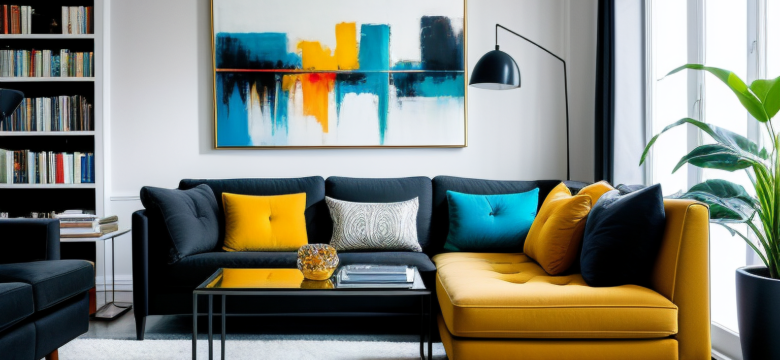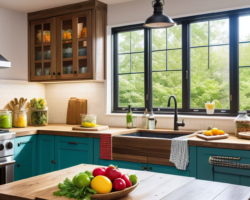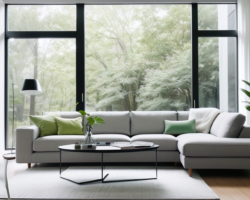Are you feeling like your living space has lost its spark? Well, you’re not alone! Many of us find ourselves in a rut, surrounded by familiar decor that no longer excites us. But fear not, transforming your home doesn’t have to be a daunting task filled with expensive renovations. In fact, with a few innovative techniques, you can breathe new life into your surroundings in no time!
Imagine walking into a room that feels fresh and invigorating, where every corner reflects your personality. It’s all about making clever adjustments that enhance functionality and aesthetics. Start by assessing your current space: look at the layout, lighting, and existing decor. Ask yourself, what do you love about this space, and what could use a little TLC? Once you’ve pinpointed areas for improvement, it’s time to get creative!
Incorporating colour schemes can dramatically alter the mood of your home. Consider creating an accent wall to add depth; this simple change can make a striking statement. Don’t forget about lighting either – the right fixtures can create a warm, inviting atmosphere that draws people in. Remember, small changes can lead to big transformations!
So, roll up your sleeves and get ready to unleash your inner designer. Your dream living space is just a few thoughtful adjustments away!
Understanding Your Space
Assessing your current living space is crucial for any transformation. It’s like being a detective in your own home! Start by taking a good look at the layout; how does the flow feel? Are there areas that feel cramped or neglected? Consider the lighting as well—natural light can make a world of difference, while dim corners might need a little extra love. Additionally, take note of your existing decor; does it reflect your personality, or is it stuck in the past?
To get a clearer picture, you might want to jot down a few observations. Here’s a simple checklist to guide you:
- Layout: Are the furniture arrangements functional?
- Lighting: Is there enough natural light? Do you need more lamps?
- Decor: What items do you love, and what can go?
Once you’ve assessed these aspects, you’ll have a solid foundation to begin your transformation. Think of your living space as a blank canvas, waiting for your unique touch. By understanding what you have, you can make informed decisions that will breathe new life into your home without the need for extensive renovations. So, grab a notepad and start your journey toward a revitalised living space!
Incorporating Colour Schemes
Colour can dramatically change the mood of a room, acting like a magician that transforms dull spaces into vibrant sanctuaries. Have you ever walked into a room and felt an instant shift in your mood? That’s the power of colour! When it comes to revitalising your living space, choosing the right colour scheme is essential. Start by considering your personality and the atmosphere you wish to create. For example, if you crave calmness, soft blues and greens can work wonders, while bold reds and yellows can inject energy and warmth into your home.
Don’t be afraid to experiment! One effective technique is to create an accent wall, which can serve as a focal point and add depth to your space. Think of it as the cherry on top of your interior design sundae. You can opt for various materials, from paint to wallpaper, each offering unique textures and patterns. Here’s a quick overview of popular colour schemes:
| Colour Scheme | Description |
|---|---|
| Monochromatic | Different shades of the same colour for a cohesive look. |
| Complementary | Colours opposite each other on the colour wheel for a vibrant contrast. |
| Analogous | Colours next to each other on the wheel, creating harmony. |
As you select your colours, pay attention to the lighting in your space, as it can alter how colours appear. Natural light can make colours look brighter, while artificial lighting may soften them. So, grab a few samples, paint swatches on your walls, and observe how they change throughout the day. It’s all about finding that perfect balance that resonates with you!
Accent Walls
Creating an accent wall is a fantastic way to inject some personality and flair into your home without overwhelming the space. Think of it as a bold statement piece that draws the eye and adds depth to your room. Whether you’re looking to highlight a particular area or simply want to spice things up, an accent wall can work wonders. You can choose from various materials and techniques to make your wall pop, such as paint, wallpaper, or even wood paneling.
When considering your options, it’s essential to think about the overall aesthetic of your room. For instance, if your decor is predominantly neutral, a vibrant colour could create a striking contrast. Alternatively, if your space is already quite busy, you might opt for a more subtle hue or texture. Here are some popular choices for creating accent walls:
- Bold Paint Colours: A bright, saturated colour can energise the space.
- Textured Wallpaper: Adds depth and interest with patterns and textures.
- Wood or Stone Panels: Brings a rustic or industrial feel to your home.
- Gallery Wall: A collection of art or photos can serve as a dynamic accent.
Ultimately, the key to a successful accent wall is to ensure it complements your existing decor while providing a focal point that enhances the overall vibe of your living space. So, grab your paintbrush or wallpaper and let your creativity flow!
Choosing the Right Paint
When it comes to transforming your living space, can feel like a daunting task, akin to picking the perfect outfit for a big event. The colour you select not only sets the mood but also reflects your personality and style. So, how do you navigate through the vast sea of options? Start by considering the existing decor and the overall vibe you want to achieve. For instance, if your space is filled with natural light, you might opt for lighter shades to create an airy feel. Conversely, darker tones can add warmth and intimacy to a room that lacks sunlight.
Next, think about the finish. Paint comes in various finishes, such as matte, eggshell, satin, and gloss. Each finish serves a different purpose:
- Matte: Great for hiding imperfections but less durable.
- Eggshell: A bit more durable and easy to clean, perfect for living rooms.
- Satin: Ideal for high-traffic areas, as it withstands wear and tear.
- Gloss: Best for accents, as it reflects light and adds a shiny touch.
Lastly, don’t forget to test samples on your walls. Paint can look different in the can than it does on your walls due to lighting and surrounding colours. By swatching a few options, you can ensure that the final choice will harmonise beautifully with your space, creating an environment that feels just right.
Using Wallpaper Creatively
Wallpaper isn’t just a relic of the past; it’s a vibrant tool for modern-day interior design! Imagine walking into a room that tells a story, a place where your personality shines through every detail. Using wallpaper creatively can transform your living space from mundane to magnificent in no time. Think of it as the icing on the cake, adding that extra flair that makes everything come together.
One fantastic way to utilise wallpaper is by creating a feature wall. This can be particularly striking in a living room or bedroom, where a bold pattern or colour draws the eye and serves as a focal point. You might choose a floral design to bring a touch of nature inside or a geometric pattern for a modern vibe. The options are endless!
Another creative approach is to mix and match different wallpapers. This technique can add depth and texture to your space. For example, consider using a vibrant wallpaper on one wall and a more subtle design on another. This contrast can create a dynamic environment that keeps the eye engaged. Just remember, balance is key—too many competing patterns can be overwhelming.
Don’t forget about using wallpaper in unexpected places! Think about applying it to the back of shelves, inside wardrobe doors, or even on the ceiling. These unique applications can surprise your guests and give your home an artistic twist. With a little imagination, wallpaper can be a versatile and exciting element in your home decor toolkit.
Lighting Enhancements
When it comes to transforming your living space, lighting is often the unsung hero. Imagine stepping into a room that feels cold and uninviting, only to flip a switch and watch it come alive with warmth and character! Proper lighting can completely alter the mood, making even the most ordinary spaces feel extraordinary. So, how do you achieve that magical transformation?
First, consider layering your lighting. This means combining different types of lighting sources to create depth. Think about ambient lighting for overall illumination, task lighting for specific activities, and accent lighting to highlight your favourite features. For instance, a well-placed floor lamp can not only brighten a corner but also serve as a beautiful decor piece.
Next, don’t underestimate the power of light bulbs. The right bulb can make a world of difference. Opt for warm white bulbs to create a cosy atmosphere, or cool white ones for a more energising feel. You can also experiment with dimmers to adjust the intensity of your lighting based on the time of day or your mood. Imagine hosting a dinner party where you can set the lights to a soft glow, creating an intimate setting. Sounds delightful, doesn’t it?
Lastly, consider incorporating smart lighting options. With the ability to control your lights via an app or voice commands, you can change the ambience of your space with ease. Want to mimic the soft glow of a sunset? Or perhaps you’d prefer a bright, energising light for your morning routine? The possibilities are endless, and they add a modern touch to your home!
Furniture Arrangement Tips
Rearranging your furniture can feel like a daunting task, but it’s one of the most effective ways to breathe new life into your living space. Have you ever walked into a room and felt like something just wasn’t right? Often, it’s all about the layout! Start by assessing how you currently use the space; are there areas that feel cramped or underutilised? A simple shift can create a more inviting atmosphere and improve functionality.
When thinking about your furniture arrangement, consider the flow of movement. You want to create pathways that allow for easy navigation through the room. Imagine your space as a dance floor; each piece of furniture should have enough room to let people glide by without bumping into anything. A good rule of thumb is to leave at least 18 inches between furniture pieces to ensure comfort and accessibility.
Creating zones within your living area can also enhance its usability. For instance, if you have a large room, think about designating a reading nook, a conversation area, or even a workspace. You can achieve this by using rugs to define each zone, as they act like visual anchors. Additionally, consider the size and scale of your furniture. Oversized pieces can overwhelm a small room, while smaller items might get lost in a larger space. Mixing sizes can add depth and interest to your layout.
Lastly, don’t forget about the importance of balance and symmetry. Arranging furniture in a way that feels cohesive and harmonious can make your space more visually appealing. For example, if you have a large sofa on one side, balance it with a couple of chairs or a side table on the opposite side. Remember, it’s all about creating a space that reflects your personality while being functional. So roll up your sleeves, move some furniture around, and watch your living space transform!
Creating Zones
When it comes to making the most of your living space, is like setting up a stage for different acts in a play. Each area should have its own purpose, allowing you to enjoy your home to its fullest. Imagine a warm corner for reading, a lively space for entertaining, and a serene nook for relaxation—all within the same room!
To effectively create these zones, start by assessing your space. Look for natural boundaries like furniture or architectural features that can help define each area. For instance, a comfy sofa can separate a lounging zone from a dining area, while a stylish rug can delineate a reading nook. This not only enhances functionality but also adds a visual appeal to your home.
Consider the following tips when designing your zones:
- Use Furniture Wisely: Select pieces that can serve multiple purposes, like a coffee table that doubles as storage.
- Incorporate Lighting: Use different lighting options to set the mood for each zone. A soft lamp can create a cosy reading atmosphere, while brighter lights can energise a workspace.
- Add Personal Touches: Decorate each area with items that resonate with you, making each zone feel uniquely yours.
By thoughtfully creating zones, you can transform your living space into a harmonious blend of functionality and style. It’s all about making your home work for you, so don’t shy away from experimenting with layouts until you find the perfect balance!
Multifunctional Furniture
In today’s fast-paced world, is like a superhero for small spaces, swooping in to save the day! Imagine a coffee table that transforms into a dining table or a sofa that converts into a bed. These clever pieces not only maximise your space but also add a touch of style to your home. It’s all about making the most of what you have without compromising on aesthetics.
When selecting multifunctional furniture, consider your daily activities and how each piece can serve multiple purposes. For instance, a stylish ottoman can double as a seat for guests and provide hidden storage for blankets or magazines. Not only does this keep your living area tidy, but it also allows for a more versatile layout. Here are some fantastic examples:
- Murphy Beds: Perfect for studio apartments, these beds fold away when not in use, freeing up valuable floor space.
- Expandable Dining Tables: Ideal for entertaining, they can adjust in size to accommodate guests, then shrink back down for everyday use.
- Storage Benches: These can serve as seating while providing ample space to stash away shoes or bags.
Ultimately, choosing multifunctional furniture is about enhancing your lifestyle. It’s like having a Swiss Army knife in your living room—versatile, practical, and oh-so-stylish!
Accessorising Thoughtfully
Accessorising your living space is like adding the final touches to a masterpiece; it’s all about the details. Thoughtful accessories can transform a bland room into a vibrant and inviting environment. Start by considering items that reflect your personality and interests. For instance, if you’re a travel enthusiast, displaying souvenirs from your adventures can spark conversations and bring back cherished memories.
When choosing accessories, think about balance and harmony. You want your space to feel cohesive, so consider how different items interact with each other. A well-placed vase or a striking piece of art can serve as a focal point, drawing the eye and enhancing the overall aesthetic. Don’t forget about the power of texture; mixing materials like wood, metal, and fabric can add depth and interest to your decor.
Incorporating plants is another fantastic way to liven up your space. Not only do they purify the air, but they also bring a touch of nature indoors. Here’s a quick list of popular indoor plants that are easy to care for:
- Snake Plant – hardy and tolerant of neglect
- Pothos – trailing vines that thrive in various conditions
- Spider Plant – great for beginners and purifies the air
Finally, art is a powerful tool in accessorising. Select pieces that resonate with you personally, whether they’re bold prints or subtle watercolours. Display them in a way that feels intentional—perhaps in a gallery wall format or as standalone statements. Remember, accessorising thoughtfully is about creating a space that feels uniquely yours!
Plants and Greenery
Incorporating plants into your living space can work wonders, breathing life and vibrancy into even the dullest of corners. Imagine walking into a room filled with lush greenery; it’s like stepping into a serene oasis! Not only do plants enhance the aesthetic appeal, but they also improve air quality, making your home a healthier environment. Think of them as nature’s air purifiers, filtering out toxins while adding a splash of colour.
When selecting plants, consider your lifestyle and the amount of natural light in your home. For instance, if you’re often busy or travel frequently, low-maintenance options like snake plants or ZZ plants are perfect. Here’s a quick guide to help you choose:
| Plant Type | Light Requirement | Maintenance Level |
|---|---|---|
| Snake Plant | Low to bright indirect light | Low |
| Spider Plant | Bright, indirect light | Low |
| Peace Lily | Low to bright indirect light | Medium |
| Fiddle Leaf Fig | Bright, indirect light | High |
To truly personalise your space, don’t just place plants randomly. Consider creating a green corner or a hanging garden. Use decorative pots that reflect your style, and arrange them in groups to create visual interest. By doing this, you’ll not only make your home more inviting but also establish a connection with nature, which can be incredibly soothing.
Art and Personal Touches
Art is the heartbeat of any living space, adding a splash of personality and character that can instantly elevate the atmosphere. Think of your walls as a blank canvas, waiting for your unique expression! Whether it’s a vibrant painting, a stunning photograph, or a quirky sculpture, each piece tells a story about who you are. But how do you choose art that resonates with you?
Start by considering your personal style. Are you drawn to bold colours and abstract forms, or do you prefer soft pastels and serene landscapes? This reflection will guide your selection. It’s also essential to think about scale—large pieces can serve as focal points, while smaller artworks can create an inviting gallery wall. You might even want to mix different sizes for an eclectic look!
When displaying your chosen art, consider creating a cohesive theme. For instance, you could group pieces by colour or style. Here’s a quick tip: use frames that complement your decor. A rustic frame can bring warmth to modern art, while sleek, minimalist frames can enhance traditional pieces. Don’t shy away from adding personal touches, like photos from your travels or handmade crafts, to truly make the space yours.
Lastly, remember that lighting plays a crucial role in showcasing your art. A well-placed spotlight or a simple picture light can enhance the colours and details, making your art pop! So, get creative, and let your living space reflect your unique story through art and personal touches.
Frequently Asked Questions
- How can I quickly assess my living space for improvements?
Start by observing the layout, lighting, and decor. Take notes on areas that feel cramped or dull. Think of it like a treasure hunt—you’re looking for hidden potential!
- What are some easy ways to incorporate colour into my home?
Consider painting an accent wall or adding colourful accessories. It’s like adding a splash of paint to a canvas; it can completely transform the vibe!
- How can I create zones in my living space?
Use furniture arrangement to define areas for different activities. Imagine your space as a stage, where each piece of furniture plays its part in creating a harmonious performance!
- What types of plants are best for indoor spaces?
Low-maintenance options like snake plants or pothos are great choices. They’re like the reliable friends of the plant world—easy to care for and always uplifting!
- How do I choose the right art for my home?
Select pieces that resonate with you personally. Think of art as the soul of your space; it should reflect your personality and spark joy every time you see it!





